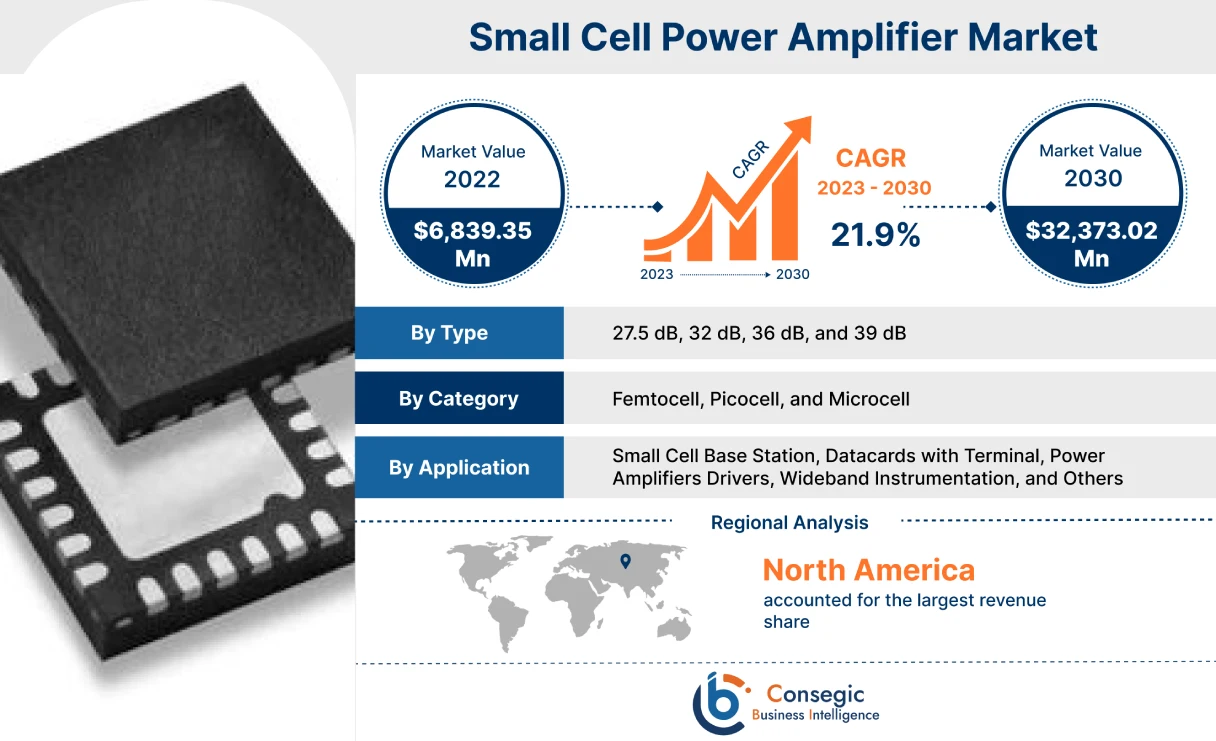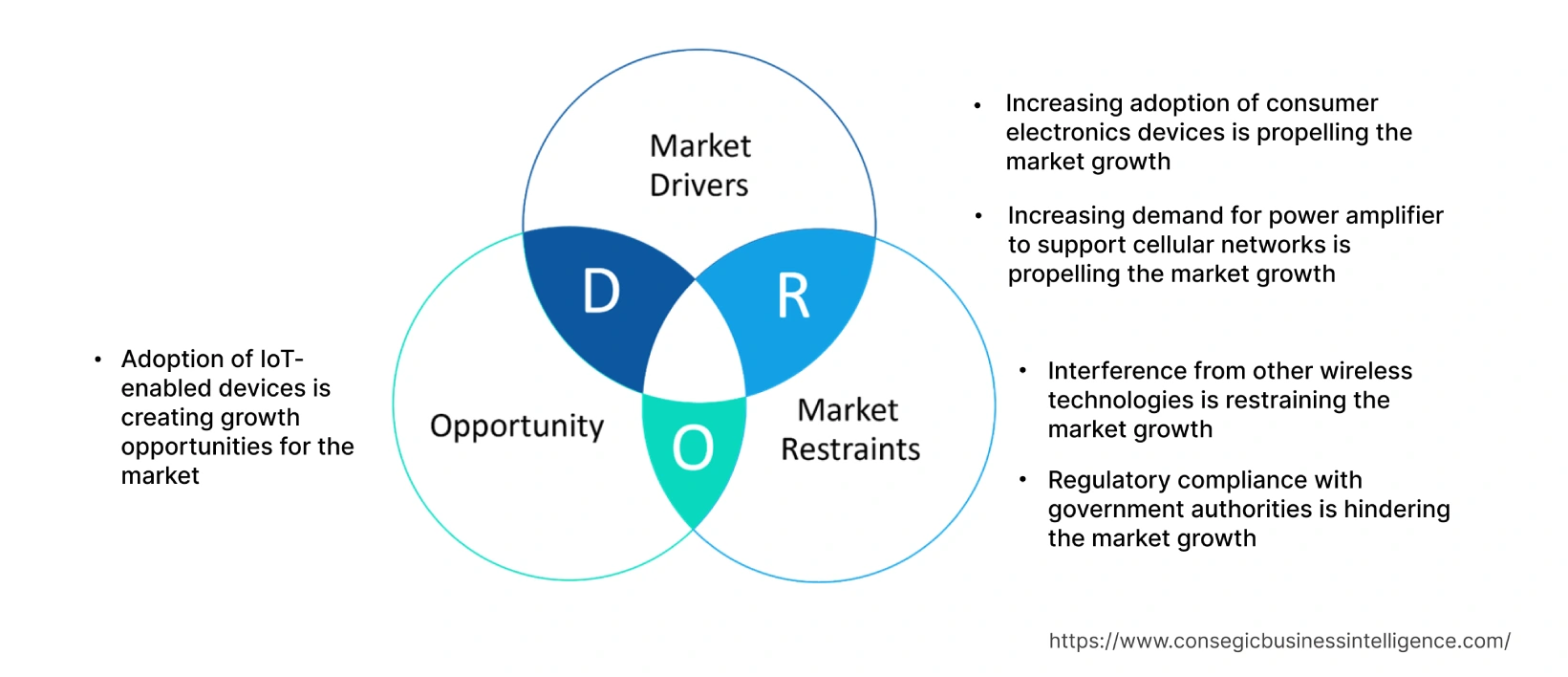- Summary
- Table Of Content
- Methodology
Small Cell Power Amplifier Market Size :
Small Cell Power Amplifier Market is estimated to reach over USD 32,373.02 Million by 2030 from a value of USD 6,839.35 Million in 2022, growing at a CAGR of 21.9% from 2023 to 2030.
Small Cell Power Amplifier Market Scope & Overview:
A small cell power amplifier is a device used in telecommunication systems responsible for boosting and amplifying signals to enhance network performance. Small-cells are low-power base stations designed to provide reliable coverage across small areas. Moreover, small cell power amplifiers improve the rate of data transmission for different spectrums, including 3G, 4G, and 5G networks. Consequently, small cell power amplifiers are used to enhance network coverage and capacity in residential, commercial, and metropolitan areas.
Small Cell Power Amplifier Market Insights :
Key Drivers :
Increasing adoption of consumer electronics devices is propelling the market growth
The increasing adoption of consumer electronics devices including smartphones, laptops, and tablets is driving the growth of the market. The increased reliance on consumer electronics devices has resulted in rise of mobile data consumption. Consumers are increasingly relying on smartphones, laptops, and tablets for communication, entertainment, and professional purposes. Thus, the surge in mobile data usage increases the demand for small cell power amplifiers to enhance network strength in residential areas. For instance, in May 2020, SARAS Technology Limited launched new linear power amplifier called SPA115 with frequency 700 to 2700MHz to support mobile communication applications covering 2G, 3G and 4G over several frequency bands. Therefore, the widespread adoption of consumer electronics devices is propelling the growth of the market.
Increasing demand for power amplifier to support cellular networks is propelling the market growth
The increasing demand for small cell power amplifier to support cellular networks is driving the growth of the market. Cellular networks require dense infrastructure that provides high speed and low latency. Small cell power amplifiers amplify the network signals to high power levels in order to cover large areas with sufficient strength. Thus, small cell power amplifiers provide enhanced coverage and capacity in dense urban areas and high-traffic locations. For instance, in June 2021, Qorvo, Inc. introduced high-efficiency power amplifiers featuring 7 GHz 3GPP frequency bands designed for small cell infrastructure applications to support 5G networks. Consequently, the increasing adoption of cellular networks for communication purposes is accelerating the growth of the market.
Key Restraints :
Interference from other wireless technologies is restraining the market growth
Small cell are designed to co-exist with existing cellular networks, Wi-Fi networks, and other wireless technologies operating in the same frequency bands. Interference from other networks degrades the quality of wireless signals, leading to reduced network performance and user experience. Thus, the presence of a large number of small cells in densely populated areas or locations is hindering the growth of the market.
Regulatory compliance with government authorities is hindering the market growth
Regulatory bodies enforce specific regulations and standards to ensure efficient use of available spectrum. Compliance with government regulations is crucial for small cell power amplifiers to ensure smooth deployment of small cells in specific areas. Thus, manufacturers and network operators need to adhere to power limits, frequency requirements, and spectrum availability for efficient operation of wireless networks. Thus, regulatory compliance with government authorities is hindering the growth of the market.
Future Opportunities :
Adoption of IoT-enabled devices is creating growth opportunities for the market
The adoption of Internet of Things (IoT)-enabled devices in the residential sector is expected to present potential opportunities for the market growth during the forecast period. IoT-enabled devices require seamless network connectivity for managing massive data generated by IoT devices. Consequently, the deployments of small cells for facilitating efficient communication between IoT devices is expected to drive the market growth during the forecast period.
Small Cell Power Amplifier Market Report Insights :
| Report Attributes | Report Details |
| Study Timeline | 2017-2030 |
| Market Size in 2030 | USD 32,373.02 Million |
| CAGR (2023-2030) | 21.9% |
| By Type | 27.5 dB, 32 dB, 36 dB, and 39 dB |
| By Category | Femtocell, Picocell, and Microcell |
| By Application | Small Cell Base Station, Datacards with Terminal, Power Amplifiers Drivers, Wideband Instrumentation, and Others |
| By Region | North America, Europe, Asia-Pacific, Latin America, and Middle East & Africa |
| Key Players | STMicroelectronics, Infineon Technologies AG, NXP Semiconductors N.V., Maxim Integrated, Texas Instruments, Broadcom, Toshiba Corporation, Yamaha, Analog Devices, Inc., Qorvo, Skyworks Solutions |
Small Cell Power Amplifier Market Segmental Analysis :
By Type :
Based on the type, the market is segregated into 27.5 dB, 32 dB, 36 dB, and 39 dB. The 36 dB segment accounted for the largest revenue share in the year 2022. Power amplifiers with 36 dB amplification level are designed to operate at multiple frequency bands to enhance the network coverage in areas with high signal losses obstacles. Moreover, 36 dB power amplifiers offer high linearity to prevent signal distortion and maintain signal integrity. For instance, in February 2023, iCana Limited launched RF front-end reference design for indoor small cells called 5G NR FR1 featuring 37/16 dB gain capacity for 5G applications. Furthermore, the thermal path is separated from electrical connection path to provide enhanced thermal dissipation, resulting in market growth.
The 39 dB segment is anticipated to emerge as the fastest-growing segment during the forecast period. 39 dB power amplifiers possess ultra-high gain capacity to enhance the coverage area of small cells. Consequently, 39 dB power amplifiers are well-suited for wireless communications infrastructure. Moreover, the efficient power consumption capabilities of 39 dB power amplifiers are accelerating the growth of the market. Power amplifiers with 39 dB amplification level are designed to consume less power while producing high network performance in densely populated areas.
By Category :
Based on the category, the market is trifurcated into femtocell, picocell, and microcell. Microcell segment accounted for the largest revenue share of 45.0% in the year 2022. Microcells are the most powerful small cells deployed on utility poles, streetlights, and on the side of buildings. Microcells have the capability to support up to 200 devices at the same time providing network coverage over longer distances. Moreover, microcells require fiber, wired, or microwave backhaul provide reliable connectivity in challenging populated areas. Consequently, the application of microcells in urban environments is propelling the growth of the market.
The femtocell segment is anticipated to witness the fastest CAGR growth during the forecast period. Femtocells are the smallest power amplifiers usually deployed for indoor environments. Femtocells are designed to be used inside homes and small businesses to improve indoor cellular connectivity. Femtocell coverage ranges from 30 to 165 feet (10-50 meters) and has the capability to support 8 to 16 devices. For instance, in October 2021, Nokia and TPG Telecom deployed 5G femtocell featuring unique modular 4G/5G Smart Node to provide superior indoor 5G coverage. Thus, the increasing adoption of connected devices in indoor environments is accelerating market growth.
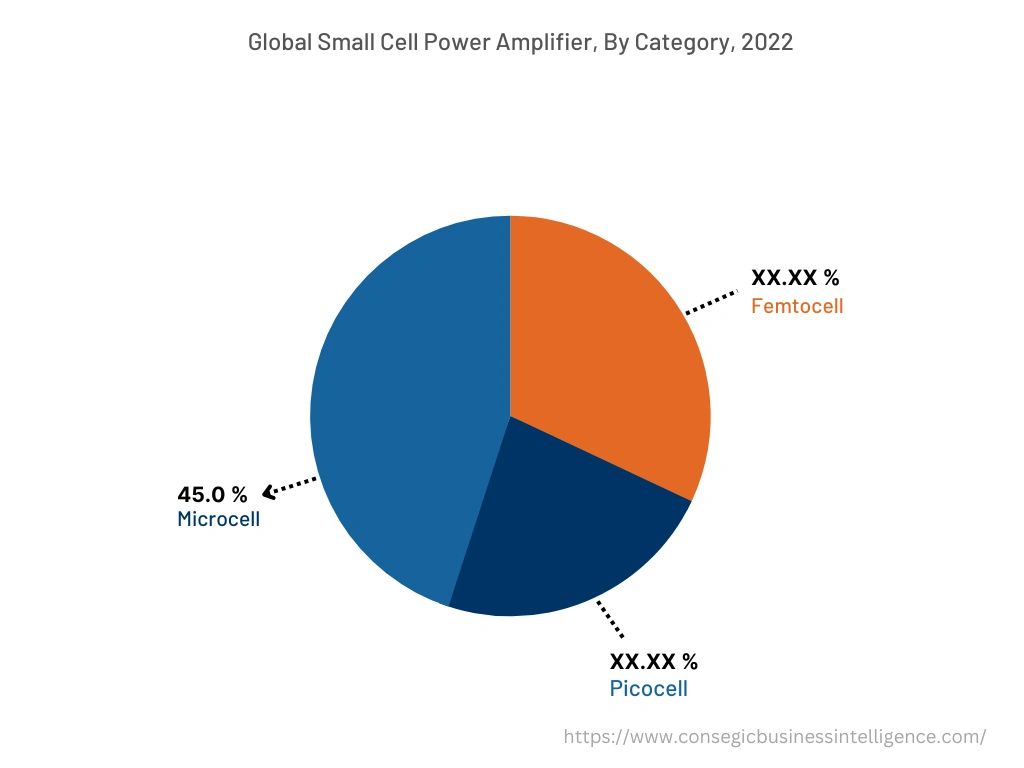
By Application :
Based on the application, the market is segmented into small cell base station, datacards with terminal, power amplifiers drivers, wideband instrumentation, and others. The small cell base station segment accounted for the largest revenue share in the year 2022. Small cell power amplifiers play a crucial role in amplifying the signals generated by base stations. As a result, power amplifiers increase the power level of the signals to ensure that the signals reach a wider coverage area and penetrate the obstacles effectively. For instance, in June 2023, Mitsubishi Electric Corporation launched gallium nitride power amplifier with frequency of 3,400MHz supporting 4G, 5G and beyond 5G/6G communication systems in single base station. Moreover, small cell power amplifiers are designed to optimize the energy consumption by base stations to minimize the operational costs of small cell base stations thereby contributing to the growth of the market.
The datacards with terminal segment is projected to register the fastest CAGR growth during the forecast period. Datacards with terminals are the devices that provide wireless connectivity to consumer electronics devices. Datacards with terminal includes dongles or datacards used in laptops, tablets, IoT devices and other portable devices. Consequently, small cell power amplifiers are integrated with datacards to provide reliable wireless connection to the devices. Therefore, the increasing adoption of portable electronic devices is propelling the growth of the market.
By Region :
The regional segment includes North America, Europe, Asia Pacific, Middle East and Africa, and Latin America.
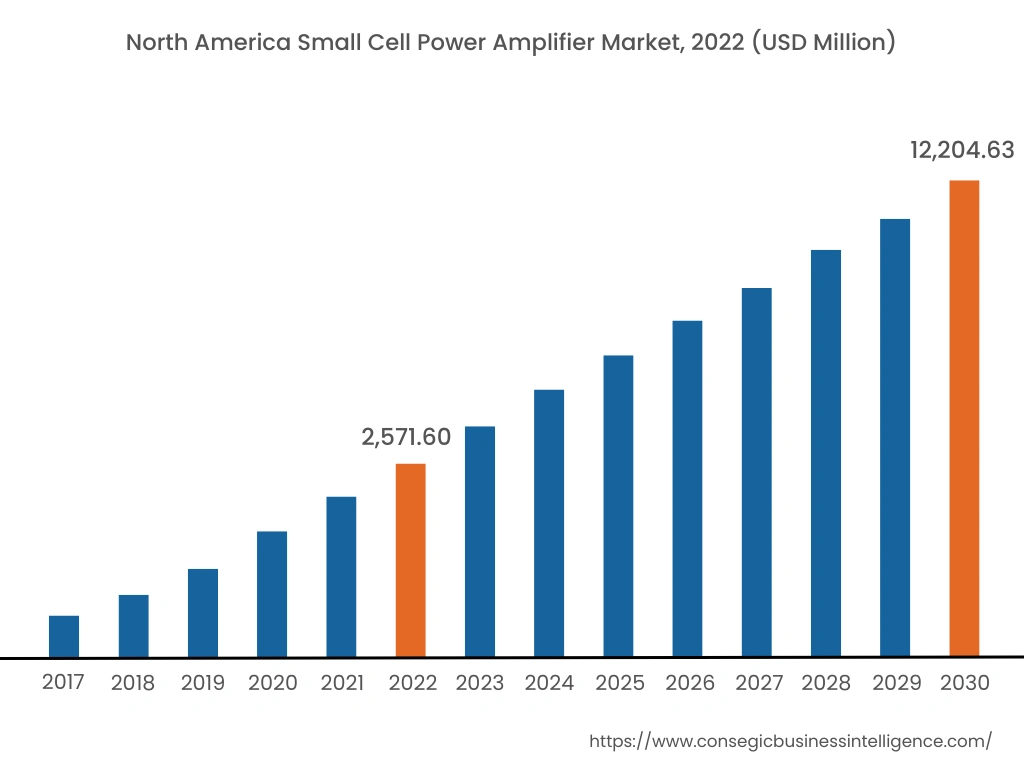
North America accounted for the largest revenue share of USD 2,571.60 million in 2022 and is expected to reach USD 12,204.63 million in 2030, registering a CAGR of 21.9% during the forecast period. Additionally, in the region, U.S. accounted for the largest revenue share of 64.45% in the year 2022. North America has a high mobile data consumption rate due to the widespread adoption of consumer electronics devices such as smartphones, laptops, and tablets. The surge in mobile data traffic requires small cell power amplifiers to provide enhanced coverage and network capacity. Moreover, the increasing adoption of IoT-enabled devices in North America is accelerating the growth of the market. Small cell power amplifiers play a crucial role in establishing efficient communication systems between the IoT devices. Moreover, the rising demand for high-data transfer speeds for communication, entertainment, and professional purposes in the region is driving the growth of the market.
The Asia-Pacific region is anticipated to grow at the fastest CAGR of 22.1% during the forecast period, 2023-30. The vast telecommunication industry in the Asia-Pacific region is driving the growth of the market. The telecommunication industry in the region is increasingly deploying small cell power amplifiers to support 5G networks. For instance, in April 2023, iCana Limited collaborated with Picocom for the development of 5G Open RAN small cell radio unit reference platform to support wireless communication systems. Moreover, the rising government initiatives to promote the adoption of 5G cellular networks is propelling the growth of the regional market.
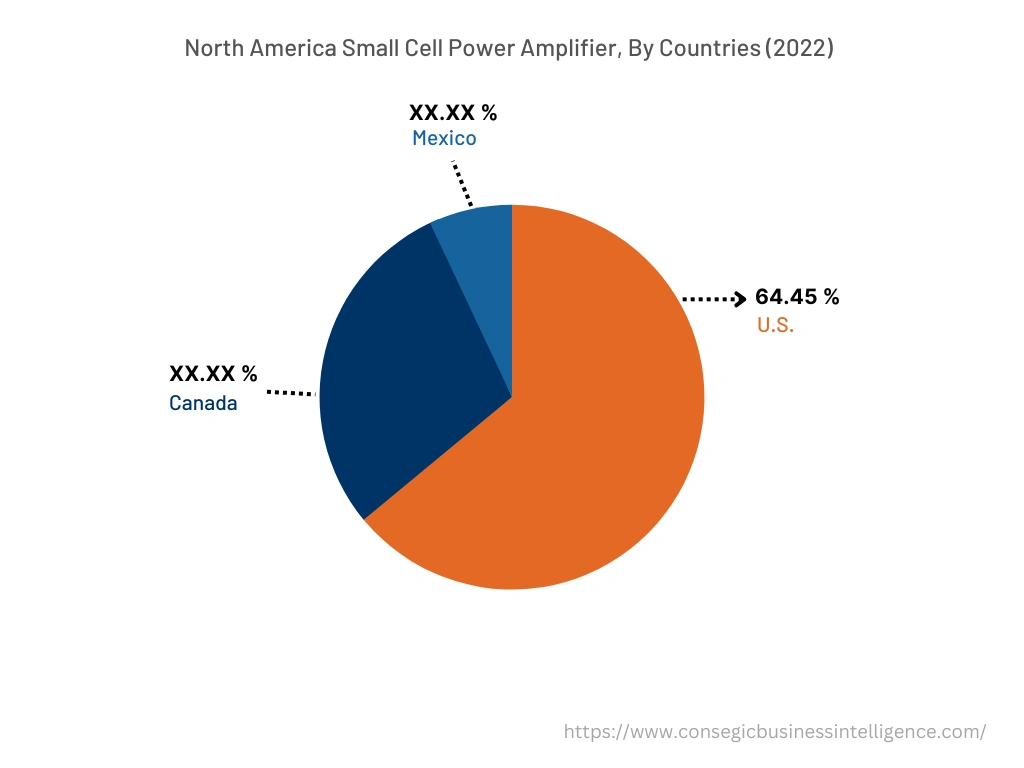
Top Key Players & Market Share Insights :
The small cell power amplifier market is characterized by the presence of major players providing power amplifiers with high gain capacity to support internet services. Key players are adopting several strategies in product innovation, research, and development (R&D), and various business strategies, and application launches that accelerate the growth of the small cell power amplifier market. Key players in the market include-
- STMicroelectronics
- Infineon Technologies AG
- Yamaha
- Analog Devices, Inc.
- Qorvo
- Skyworks Solutions
- NXP Semiconductors N.V.
- Maxim Integrated
- Texas Instruments Incorporated
- Broadcom
- Toshiba Corporation
Recent Industry Developments :
- In June 2022, CML Microcircuits launched 5G Medium Power Amplifier called CMX90A702 with frequency 28 GHz for 5G mmWave infrastructure applications, including small cells, repeaters, passive antenna arrays and 5G backhaul applications.
- In June 2023, Guerrilla RF, Inc. launched two new high gain amplifiers called GRF5123 and GRF5124 providing high level of linearity 5G mMIMO transmitters.
Key Questions Answered in the Report
What is small cell power amplifier? +
Small cell power amplifiers are low-power base stations designed to provide reliable coverage across small areas.
What specific segmentation details are covered in the small cell power amplifier report, and how is the dominating segment impacting the market growth? +
By category segment has witnessed microcell as the dominating segment in the year 2022, due to its ability to provide network coverage in large and diverse areas.
What specific segmentation details are covered in the small cell power amplifier market report, and how is the fastest segment anticipated to impact the market growth? +
By type segment has witnessed 39 dB as the fastest-growing segment during the forecast period due to its ultra-high gain capacity and low power consumption.
Which region/country is anticipated to witness the highest CAGR during the forecast period, 2023-2030? +
Asia-Pacific region is expected to register fastest CAGR growth during the forecast period due to the vast telecommunication industry in the region.
